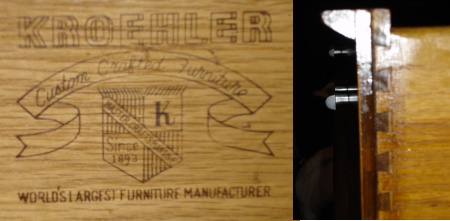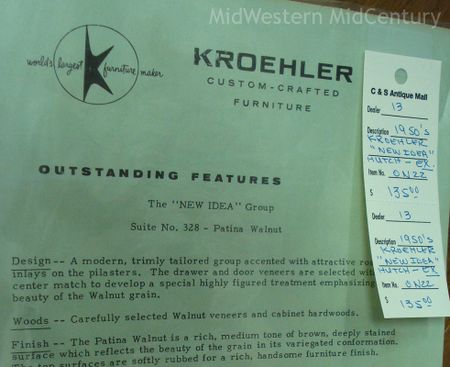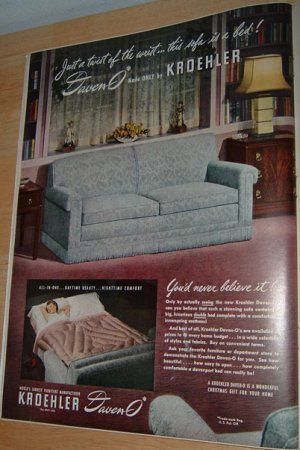Now that the dresser is home and finished and looking good and everything, I’ve been meaning to do some detective work. I kinda dig on history – particularly digging into the small nooks and crevices in between the history everyone knows – so I took some time this afternoon to see what I could find out about this dresser’s origins.
Inside one of the drawers is an elaborate logo printed in the wood, declaring its origin to be Kroehler “Custom Crafted Furniture”. The logo also says that the company was founded in 1893.

Doing a quick Google search I found this short piece:
Kroehler Manufacturing Co.
In 1902, Peter E. Kroehler bought the Naper ville Lounge Co., a maker of wooden lounge chairs and upholstered furniture. Kroehler built a new factory in Naperville in 1913 after the original facility was destroyed by a tornado. Soon thereafter, he renamed the company Kroehler Manufacturing Co. This enterprise soon operated across the country and employed several hundred men and women in the Chicago area. By the middle of the 1940s, with over $20 million in annual sales, Kroehler was the second-largest furniture maker in the United States. During the 1960s, when the company employed close to 8,000 people around the country, annual revenues passed $100 million. The company struggled during the 1970s, closing its historic Naperville factory in 1978 and ending its operations in the area. In 1981 Kroehler was acquired by the ATR Group of Northbrook, which put the com- pany up for sale. By the early 2000s, furniture was still manufactured under the Kroehler name by two unrelated companies, one in North Carolina and the other in Ontario, Canada.
Okay, so that adds up. And the Kroehler brand is still around, albeit in Canada. As the blurb above says, it seems to be the same brand.
Kristi has mentioned to me several times that she believes that the dresser was built in the post-war era, based on how the wood joints in the drawers seem to be pretty well machine-cut (see above photo, right). A dresser built prior to the Second World War would have been built mainly by hand. We wouldn’t be seeing those precise die cuts in the wood.
According to this website, Naperville Lounge Factory was wrecked by a cyclone in the early 1900’s, rebuilt, and renamed the “Kroehler Furniture Company” in 1913.
The more photos I see online of Kroehler furniture, the more this looks like their mid-1950’s design style. The under-the-drawer pulls were common features in their dressers of that era (the dresser in this photo is a 1956 Kroehler, or so the photo owner claims).

Or could it be older? The furniture they were designing by 1960 doesn’t look anything like our dresser; this one has too many 1940s/1950s design elements. However, I’ve been finding this logo around online attributed to the Kroehler of 1956 or so, and apparently they were imprinting it in the wood:

And here is the logo again, the Kroehler “New Idea Group”, 1950’s:

That’s the mid-1950’s Kroehler logo – the one on our dresser is older. I believe these are photos (click link to see) of the kind of dresser Kroehler was making by the late 50’s, early 60’s. Again, an even more modernized logo. Those fonts? That’s 1958. Maybe 1962. The design elements in our Kroehler logo are obviously more dated than that.
Ahh.. more history..
During WWII, rationing and restrictions on raw materials such as the wire and lumber needed to produce furniture affected operations at Kroehler. The company sought contracts from the government for war work, making furniture and filing cabinets for U.S.O. offices, duffel bags and artificial limbs for soldiers. After the war, Kroehler experienced the largest workers’ strike in its history, when more than 2,500 workers protested for higher wages. The strike lasted from August 1946 to January 1947 and cost the company over $1 million.
After the death in 1950 of company founder Peter Edward Kroehler, technological changes prompted the development of a new system of production at Kroehler, called the G & L System after the engineers who invented it. Fifteen workers made up a production line, each one making a different part for a particular piece of furniture. All of the workers in a production line then assembled the final product together. By the mid-1950s, Kroehler was delivering 128 truckloads of furniture a day to stores.
Okay. So the founder died in 1950 and they made a lot of changes. Sounds like the perfect time for a rebrand, marketing redesign, etc. Then I stumbled on this old Kroehler ad from 1949:

BINGO. Check out that Kroehler block font on the bottom, baby.
How old it the dresser exactly? We’ll likely never know. But I’m putting my money on about 60 years, built sometime between the 1947 strike and the 1950 death of Peter Kroehler. 1949-ish would be my best bet.
